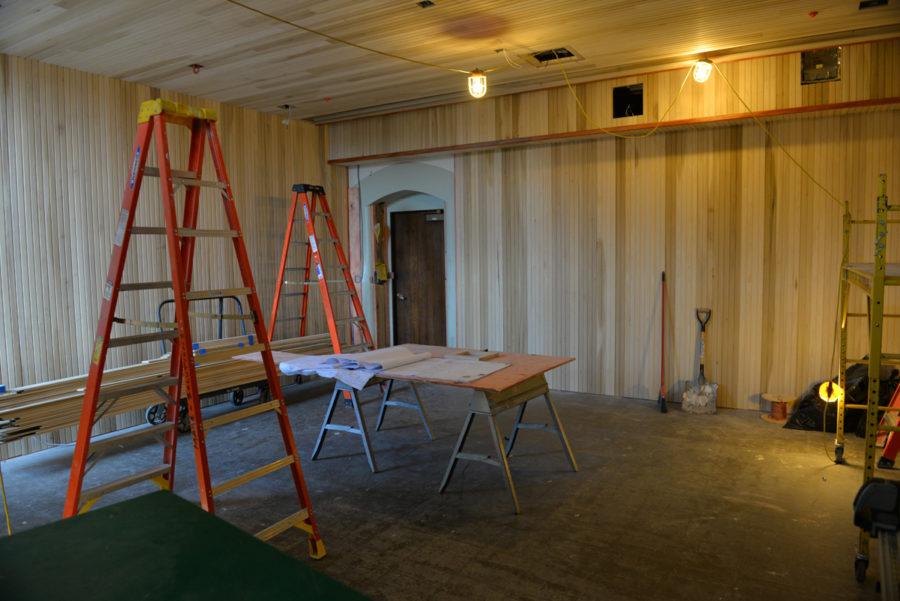Philippine Nationality Room highlights need for diversity
The Philippine Nationality room, currently under construction, will join the three existing East Asian heritage room. (Photo by Jon Kunitsky | Staff Photographer)
August 29, 2018
Work on the Philippine Nationality Room began last May and is expected to wrap up by November 2019, meaning construction on the room will take a far shorter time than its fundraising did.
The Philippine Nationality Room Task Force spent 16 years campaigning for the creation of this room, which will officially become Pitt’s 31st Nationality Room and the fourth room representing East Asian heritage upon completion.
This is an important step in diversifying the Nationality Rooms, 20 of which represent white European countries. Those rooms more adequately represented Pittsburgh’s demographics when the first few Nationality Rooms were dedicated in the 1930s, at a time when the City’s European immigrant community was thriving. But Pittsburgh has become more of a melting pot in recent years — the Latino community in particular is rapidly growing. The University needs to reflect such changes by expanding the available space for rooms and assisting in funding their construction — and the Year of Pitt Global, this academic year’s theme, could serve as a way to jump-start this movement.
According to Michael Stefanick, a member of the Filipino Students Association — the organization responsible for making the Philippine Room a reality — Nationality Rooms mean a lot to the communities they represent.
“It means greater representation for not only the Philippine community here on campus but in the greater Pittsburgh area,” Stefanick told The Pitt News.
Students with backgrounds from continents other than Europe deserve to see themselves represented with respectful portrayals of the specific cultures they are familiar with. The African Heritage Room, built in 1989, has provided students of African backgrounds with a semblance of this — but it rolls up the entire continent of Africa into one space. With 24 percent of Pittsburgh’s population listed as African-American, individual African countries deserve their own rooms.
But if Africa’s representation is inadequate, Latin America’s is even worse. There isn’t a single room dedicated to countries in South America, the Caribbean or Central America. While the Latin community only hovers around 2 percent of Pittsburgh’s population, it’s steadily grown over the past decade.
Unfortunately, it can take a lot of time and effort for communities — especially growing ones — to raise funds to pay for a Nationality Room — each room costs over half a million, on average. The Philippine Room took 16 years of campaigning to reach approval, and the final estimated cost was around $525,000.
Nationality Rooms are not only expensive — the approval process has become a competitive endeavor.
“The Cathedral is running out of space, which makes Nationality Rooms a very sought-after commodity for cultural groups around Pittsburgh,” Stefanick said.
The Cathedral only designated space for 35 rooms — after the Philippine Room, only four will be left. And since two of those are slated to become Finnish and Iranian, the battle for space will only become more cutthroat in future years.
To combat this problem, Pitt should continue the Nationality Rooms on the Cathedral’s second floor — they’re now solely on the first and third floor. Many classes meet on the second floor, so students from all backgrounds can see themselves represented in their very own classrooms — certainly a valuable cultural experience for all students.
And in the Year of Pitt Global, Pitt has the chance to take a big step. By opening the second floor to Nationality Rooms, Pitt would make dozens of rooms available. This year is the perfect opportunity for Pitt to begin expanding the amount of space we allocate to building Nationality Rooms.
“Nationality Rooms are an attraction for tourist groups,” Stefanick said. “Representation among other nations there shows the Philippines is just as important as any other established room in the Cathedral of Learning.”
The University can also help some of Pittsburgh’s growing, underrepresented international groups launch campaigns to create rooms. Pitt can do so by working with a community to host fundraising events, make connections and raise general awareness for the group’s campaign.
Ultimately, Pitt must first expand access to the Cathedral and open more space for Nationality Rooms, and communities that want representation will surely continue to campaign. Only 400 Filipinos reside in Pittsburgh — which just shows there’s no community too small to be appreciated here at Pitt.
The makeup of the community at Pitt and the city surrounding it has changed dramatically since the first few Nationality Rooms were completed. The University’s most renowned landmark must prepare to change with it.








